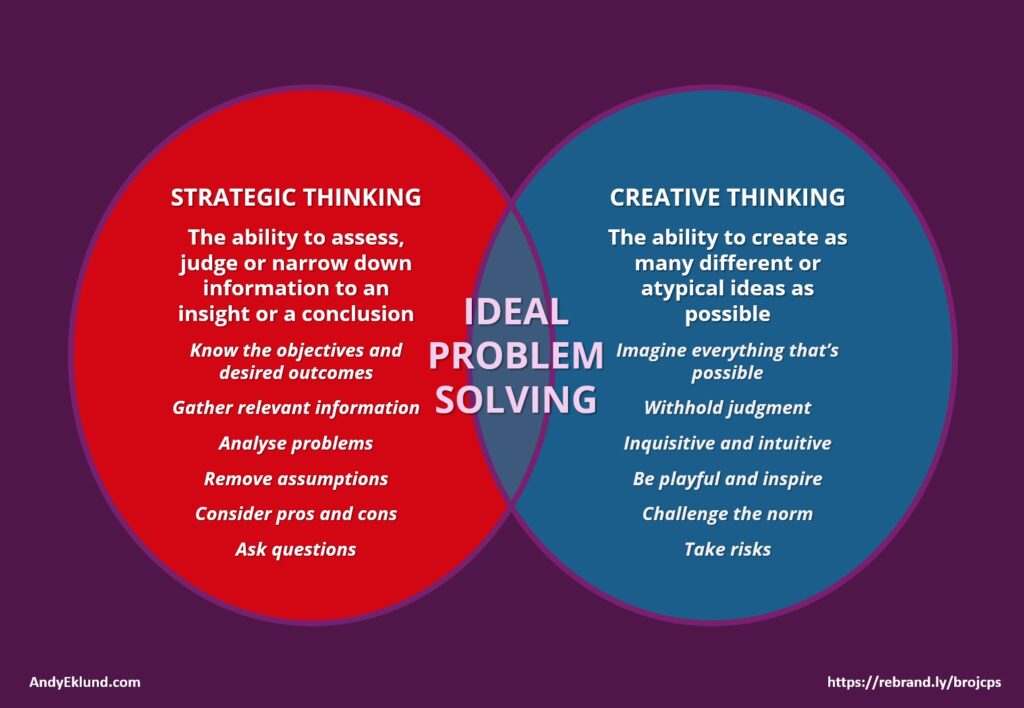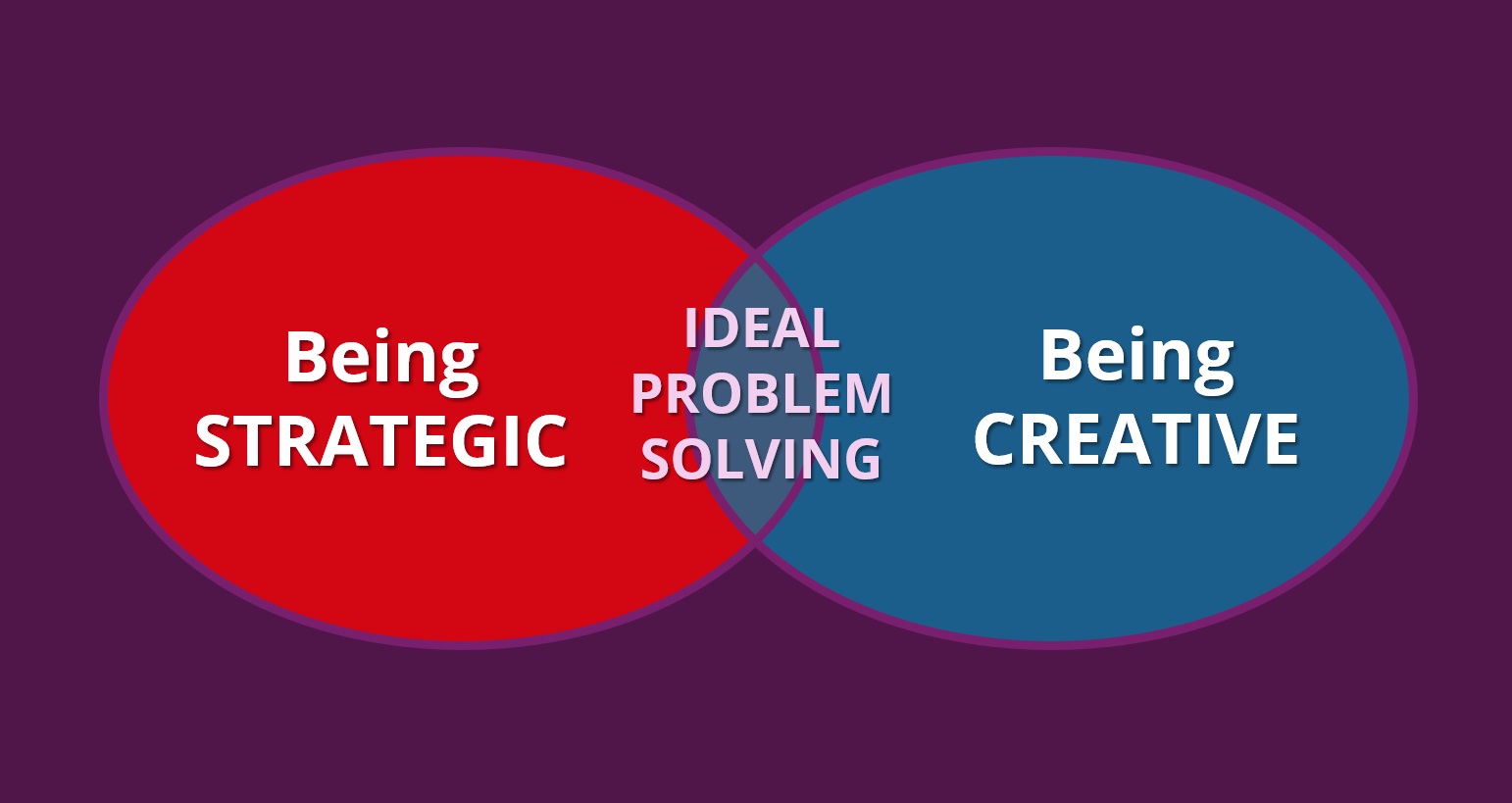At a recent meeting, a senior leader used strategic or creative in ways that I instantly knew he did not know the difference between the two words. Later, when I was alone with our team to debrief after the meeting, I realised our own people couldn’t define exactly what the phrases meant either.
Even several years later, when I began to teach full-time, I witnessed over and over that strategic or creative is a muddy pool, even though the two thinking styles are completely different.
A fellow teacher made a point once that perhaps the two words of strategic or creative are used so regularly that the definitions have grown stale, like eating too frequently a favourite dish, or hearing too often a favourite song on the radio.
While probably true, unfortunately, by not fully understanding the words strategic or creative, it means the vagueness gets in the way of:
- Developing a proper objectives, strategies and tactics for an upcoming project
- Setting the proper expectations amongst the team of the plan, research and resources
- Implementing the plan and solutions in the right way, and
- Measuring the lot to see if the outcome aligns with the project’s goals
For all these reasons, I’d like to offer my own thoughts to clarify both aspects.
Agree? Disagree? Feel free to add your thoughts in the Comments section at the bottom of this page.
Being Strategic means you ...
Know and understand the project’s objective, and more so, to know your role in moving the project toward its successful conclusion
Analyse and prioritize problems – such as external threats and internal weaknesses – which might prevent the objective from being reached
Determine what trends or opportunities can be leveraged to address or eliminate the real or potential problems
Judge or assess a piece of information for its intrinsic worth. In other words, what insight have we learnt? How might we apply those insights to this project?
Know the available and potential resources, and determine how to use them most efficiently and effectively
Define the for selecting or choosing any option, including ideas generated in a brainstorm or conversation
Measure both your final outcome, as well as the milestones along the project’s path, to ensure the project achieves its goal
Develop a focused plan of action if warranted
The question that guides your strategic thinking is usually Yes or no?
Being Creative means that you ...
Create as many potential ideas as possible, using the insights as an initial springboard
Withhold and prevent premature judgment, both from others as well as yourself
Be intellectually playful, tapping into a full range of diverse people to help look at the problems from every perspective
Take risks, even perhaps to fail if it means learning something insightful that could be used in the future
Can articulate your thoughts, most importantly, either 1) the insight from your knowledge in a way which others can acknowledge and understand, or 2) the idea itself, bringing it to life so others understand it
Be non-conformist, especially to treat the status quo as another piece of information rather than a restriction
Seek ambiguity, uncertainty and disorder because this creates new and different explorations, explanations and experiences which creates potential answers
Inspire the people around you, igniting their curiosity and imagination through your enthusiasm and passion
The questions that guides your creative thinking is typically What if … ?
Knowing the Difference is Your Value
Your value in this discussion comes from …
- Understanding the differences and why, and
- Applying the right thinking and tools at the right time
If you’re being strategic, your strategic value refers to how quickly you can assess, narrow or judge information to a conclusion, which could mean any of the following: a decision, a recommendation or an insight, all of which link directly to the project’s objective.
If you’re being creative, your creative value refers to how many different or atypical ideas you create using actual or imaginary stimuli.
Of course, it’s ideal to be able to think in either mode proficiently, similar to being able to switch between strategic or creative. Equally important, remember that all thinking styles – not just strategic or creative – have their advantages and disadvantages, depending upon the situation and the people involved.
Consequently, you can define real fluency in thinking generally in three ways:
- Knowing when to think in a certain style
- Knowing how to switch from one style to the other
- Helping your team and people around you understand and apply the appropriate thinking style at the right time
Some Additional Tools and Thoughts
Unsurprisingly for the people who know me, this topic between strategy vs creativity is one of my favourites.
Here are four of my most popular articles which you might find helpful:
The Steps of Strategic Thinking
Strategic Thinking and Creative Thinking Together
Being Strategic and Creative Together
For those connecting strategic thinking and communications planning, you may try Strategic Communications Planning, one of my top five posts, as well as being the most popular tool I use in my workshops and training.
Here are two articles based on other people’s intelligence of creativity:
10 Characteristics of a Creative Person, by John Keil.
Characteristics of the Creative Individual, by James Evans.
Finally, here too is a good article on Medium by Julie Zhuo: How to Be Strategic.
How have you defined being strategic or being creative? What tricks do you use to get your brain to switch from one style to the other? Please add your thoughts and comments below.



No comment yet, add your voice below!